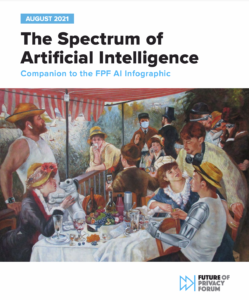The Spectrum of AI: Companion to the FPF AI Infographic
In December of 2020, FPF published the Spectrum of Artificial Intelligence – An Infographic Tool, designed to visually display the variety and complexity of Artificial Intelligence (AI) systems, the fields this science is based on, and a small sample of the use cases these technologies support for consumers. Today, we are releasing the white paper: The Spectrum of Artificial Intelligence – Companion to the FPF AI Infographic to expand on the information included in this educational resource, and describe in more detail how the graphic can be used as an aide in education or in developing legislation or other regulatory guidance around AI-based systems. We identify additional, specific use cases for various AI technologies and explain how the differing algorithmic architecture and data demands present varying risks and benefits. We discuss the spectrum of algorithmic technology and demonstrate how design factors, data use, and model training processes should be considered for specific regulatory approaches.
Artificial intelligence is a term with a long history. Meant to denote those systems which accomplish tasks otherwise understood to require human intelligence, AI is directly connected to the development of computer science but is based on a myriad of academic fields and disciplines, including philosophy, social science, physics, mathematics, logic, statistics, and ethics. AI, as it is designed and used today, is made possible by the recent advent of unprecedentedly large datasets, increased computational power, advances in data science, machine learning, and statistical modeling. AI models include programming and system design based on a number of sub-categories, such as robotics, expert systems, scheduling and planning systems, natural language processing, neural networks, computer sensing, and machine learning. In many cases of consumer facing AI, multiple forms of AI are used together to accomplish the overall performance goal specified for the system. In addition to considerations of algorithmic design, data flows, and programming languages, AI systems are most robust for use in equitable and stable consumer uses when human designers also consider limitations of machine hardware, cybersecurity, and user-interface design.
This paper outlines the spectrum of AI technology, from rules-based and symbolic AI to advanced, developing forms of neural networks, and seeks to put them in the context of other sciences and disciplines, as well as emphasize the importance of security, user interface, and other design factors. Additionally, we seek to make this understandable through providing specific use cases for the various types of AI and by showing how the different architecture and data demands present specific risks and benefits.
Across the spectrum, AI is a combination of various types of reasoning. Rules-based or Symbolic AI is the form of algorithmic design wherein humans draft a complete program of logical rules for a computer to follow. Newer AI advances, particularly in machine learning systems based on neural networks, are able to power computers that carry out the programmer’s initial design but then adapt based on what the system can glean from patterns in the data. These systems can score the accuracy of their results and then connect those outcomes back into the code in order to improve the success of succeeding iterations of the program.
AI systems operate across a broad spectrum of scale. Processes using these technologies can be designed to seek solutions to macro level problems like environmental challenges: undetected earthquakes, pollution control, and other natural disaster responses. They are also incorporated into personal level systems for greater access to commercial, educational, economic, and professional opportunities. If regulation is to be effective, it should focus on both technical details and the underlying values and rights that must be protected from adverse uses of AI, to ensure that AI is ultimately used to promote human dignity and welfare.
A .pdf version of the printed paper is available here.



